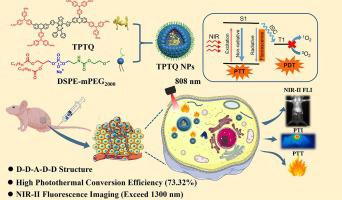Chemical Engineering Journal ( IF 15.1 ) Pub Date : 2023-05-25 , DOI: 10.1016/j.cej.2023.143726 Hongyan Shen , Binbin Wu , Qin Zhang , Jiahao Ni , Manshan Liang , Yanlong Liu , Xu-Feng Zang , Shihua Wang , Yun-Yun Quan , Xiaoxia Ye , Zu-Sheng Huang

|
Aggregation-induced emission luminogens (AIEgens) with second near infrared (NIR-II) fluorescence and photothermal therapy (PTT) have recently attracted great research interest. The formidable challenge, the competing balance between radiation-mediated NIR-II fluorescence imaging and non-radiation NIR-PTT, prevents the development of efficient NIR-II AIEgens. In this study, a quite strong photothermal agent TPTQ is developed via rational design, which involves planarizing acceptor and π-bridge and rotating donor. The strong electron-withdrawing moiety 6, 7-diphenyl-[1,2,5]thiadiazolo[3,4-g]quinoxaline is selected as the acceptor and thiophene is fabricated as the π-bridge. The planarization of π-bridge and acceptor units can enhance the intramolecular charge transfer effect, which makes TPTQ possess a long imaging wavelength longer than 1300 nm. Moreover, phenothiazine is utilized as the donor and triphenylamine is engineered on the donor part as a rotor to optimize the AIE-active characteristic and photothermal conversion efficiency of TPTQ. Notably, the TPTQ nanoparticles (NPs) achieve the highest photothermal conversion efficiency of 73.32% among the reported photothermal agents with NIR-II fluorescence imaging capability. Extensive tests in vivo indicate that the constructed TPTQ NPs can not only serve as a superior NIR-II fluorescence imaging (FLI) for the blood vessels of mice but also be successfully applied in 4T1 tumor-xenografted mice for the outstanding photothermal imaging (PTI), demonstrating distinguished FLI-guided photothermal tumoricidal capability. Herein, the smart design of acceptor/π-bridge planarization and donor rotation provide a new approach of developing highly effective NIR-II photothermal therapeutic agents.
中文翻译:

用于设计具有高光热转换效率的 NIR-II AIEgen 以增强癌症光疗的受体/π 桥平面化和供体旋转操作
具有二次近红外 (NIR-II) 荧光和光热疗法 (PTT) 的聚集诱导发光剂 (AIEgens) 最近引起了极大的研究兴趣。巨大的挑战,辐射介导的 NIR-II 荧光成像和非辐射 NIR-PTT 之间的竞争平衡,阻碍了高效 NIR-II AIEgens 的发展。在这项研究中,通过合理设计开发了一种相当强的光热剂TPTQ ,其中包括平坦化受体和π-桥以及旋转供体。强吸电子基团 6, 7-联苯基-[1,2,5]噻二唑[3,4- g]quinoxaline 被选为受体,噻吩被制造为 π-bridge。π桥和受体单元的平面化可以增强分子内电荷转移效应,使TPTQ具有大于1300 nm的长成像波长。此外,吩噻嗪用作供体,三苯胺作为转子设计在供体部分,以优化TPTQ的 AIE 活性特性和光热转换效率。值得注意的是,TPTQ纳米粒子 (NPs) 在报道的具有 NIR-II 荧光成像能力的光热剂中实现了 73.32% 的最高光热转换效率。广泛的体内测试表明构建的TPTQ NPs不仅可以作为小鼠血管的高级 NIR-II 荧光成像 (FLI),还可以成功应用于 4T1 肿瘤异种移植小鼠,以获得出色的光热成像 (PTI),展示出卓越的 FLI 引导的光热杀瘤能力。在此,受体/π-桥平面化和供体旋转的智能设计为开发高效 NIR-II 光热治疗剂提供了新途径。



























 京公网安备 11010802027423号
京公网安备 11010802027423号